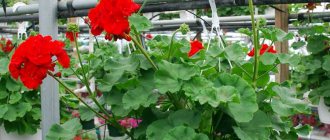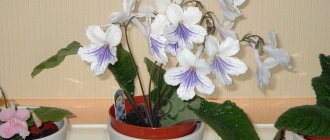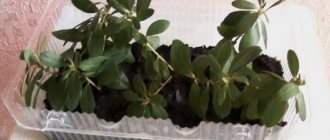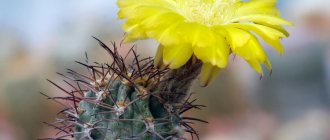Canna is an ornamental perennial that belongs to the family Cannaceae. The first flowers were exported from India, China, South and Central America. It was brought to the European continent by Portuguese ships in the 16th century. The ancient Greek designation can be translated as “reed”, the Latin - “pipe”. An ancient Indian legend tells that the leader of one of the tribes decided to burn the peace treaty in a fire, and a bloody massacre broke out. At the site of the fire, flowers with bloody petals grew, reminiscent of flashes of flame or spilled blood.
Description of the canna flower
The branched rhizomes of the perennial plant spread widely to the sides. Thickened hollow stems from 0.6 to 3 m end in a peduncle. Large leaves in the form of an ellipse or elongated shape have a length from 25 to 80 cm, a width from 10 to 30 cm at the top, sharp, with a smooth surface. The inflorescences and foliage are decorative. The green mass comes in attractive colors, ranging from malachite, maroon, red-brown to lilac.
The inflorescences of the plant, collected in a panicle or brush, are distinguished by a variety of colors. Bloody, golden, soft pink, amber, speckled, bordered, asymmetrical, they resemble a gladiolus or an orchid. Upon fertilization, a three-locular capsule appears.
Varieties of cannas
Almost all modern varieties are descended from the Indian species of canna. The cultivated descendants are given the botanical designation Canna hortum.
| View | general description | Height, m | Varieties |
| Crozy | Appeared in 1861. The leaves are malachite or dark burgundy with white. The petals are bent. | 0,6-1,6 |
|
| Orchids | Flowers up to 12.5-17.5 cm in diameter, edges in the form of folds. Dark green or lilac-green tone of leaves. | 1-2 |
|
| Deciduous (Small-flowered) | The leaf is malachite, lilac or green-green in color. The flowers are small, up to 6 cm in diameter. | 3 | Durban: Orange-yellow flowers, striped green leaves. |
Growing canna in the garden
The flowers are unpretentious and can be successfully grown in the garden and in public places. Reproduction is carried out by dividing the tubers and by sowing seeds.
Crozy
Sowing canna seeds
Typically, plants were cultivated using this method for breeding purposes. Canna seeds of easily germinating varieties for garden plots appeared quite recently, but quickly gained popularity.
Seeds begin to germinate in late January-early February. The durable shell does not allow the flower to germinate quickly.
To speed up the process, they help it collapse. It is recommended to use one of the methods:
- treated with boiling water;
- keep for 3-4 hours in a thermos with hot water;
- bury it in a snowdrift for 2-3 hours or put it on the freezer shelf for 1 hour;
- act mechanically.
After this treatment, the seeds are placed in an aqueous solution of a growth stimulator for 24 hours. The prepared seeds are placed in bowls with planting soil to a depth of 0.7-1 cm, after watering they are covered with film and removed for germination, which lasts for a month. At this time, conditions are created in the soil so that its temperature remains at +22 ºC. After 3-4 leaves grow, the seedlings are transferred to separate containers. Flowers develop in them before being transplanted outside. After 3-4 days, the picked seedlings are kept in a room with a temperature of +16...+18 ºC.
Growing from rhizomes
Dividing the rhizome is a reliable way to propagate cannas. It begins in the last ten days of March - the first days of April. The roots, stored in the cellar over the winter, are cleaned and the dried parts are separated. Each is cut into sections, focusing on the number of buds on the tuber. Those who are close do not share.
To prevent infection by fungal diseases, the resulting sections are treated with potassium permanganate (0.2 g per 1 liter of water) or wood ash.
The prepared cuttings are planted in the ground, consisting of equal parts of soil, peat chips and rotted manure. You shouldn't go deep. Germination of the first leaves should be expected in 2-3 weeks. As they appear, the pots are moved to well-lit rooms, where they will be at a temperature of +16...+18 ºC. Under the created conditions, new shoots do not stretch and develop in time. Minor watering and keeping the temperature down is all the care young seedlings need.
Seed processing and preparation
If you want to know how to grow cannas from seeds, then you must understand that you need to carry out at least minimal processing in order to provoke better germination. Cannas have a very strong shell, which is why germination may not only be delayed, but may not occur at all. Therefore, at the very first stage, it is necessary to slightly destroy it to make it easier for the sprout to break through. There are 2 methods by which seeds are usually treated. They are described in more detail below.
- Since regular soaking is unlikely to make it easier for the sprout to peck, you can carry out scarification. The procedure involves damaging the shell using sandpaper or simply filing on both sides. It is important to be especially careful here, as there is a risk of damaging the inside, and because of this the sprout will not appear at all. If you are not sure about this method, it is better to use another one.
- For example, you can place the seeds in the snow, on the bottom shelf of the refrigerator, or simply in cold water for a couple of hours. After the specified time has passed, the grains are again soaked in warm liquid for two hours. Amateur gardeners note that it is better to scald them with boiling water instead of soaking them in warm water. Be careful and try to immediately remove the seeds from it, otherwise they may completely cook. During this procedure, a characteristic cracking sound may be heard. Don't be alarmed, because it's just their shell bursting. Instead of scalding with boiling water, you can also keep them on the battery for about 12 hours.
When to plant cannas
Cannas are transferred to open ground after the end of return frosts. Damaged roots can take a long time to germinate, development lags behind, delaying flowering, and possibly its complete absence.
Deciduous
Soil selection
Planting flowers requires a sunny place, protected from drafts and wind. Canna loves humus-enriched, warm soils. The garden space is prepared in advance. To do this, dig a hole with a diameter of 0.5-0.6 m. The bottom is filled with fresh manure 0.2 m high. Due to it, the rhizome will become warmer, the flower will actively develop and bloom well. Soil is poured on top of the manure. The rhizome is placed in the spilled hole, with the growth point facing upward, and sprinkled with earth. The planting depth of unsprouted rhizomes is no more than 6-9 cm. A distance of 0.5 m is maintained between plants, and 0.3 m between dwarf varieties. The same is maintained between rows in the case of a large number of seedlings. Mulching the planted flowers allows you to protect the plantings from lack of moisture and weed germination. After planting, it takes 2 weeks for sprouts to appear; 1.5-2 months pass before flowering. At temperatures below +15 ºC, the emergence of seedlings is delayed.
Then the flowers require timely watering, loosening of the top layers of soil and fertilizing.
Care: the main thing is not to let it dry out
Further caring for your canna will not be difficult for you. Don’t forget to water these beautiful creatures regularly, once or twice a week, and after watering, loosen the soil and remove weeds.
To retain moisture in the soil and also prevent the proliferation of weeds, you can mulch the soil around the cannas with sawdust or organic material. From the end of August we begin a gradual reduction in watering for normal ripening of rhizomes.
How to fertilize cannas
Throughout the growing period, cannas are given additional feeding for timely development. Along with watering, add 2 g of potassium permanganate to a bucket of water (or place granules under each plant). This stimulates the start of flowering. Before flowering, nutrition is applied in the form of a solution of chicken manure and water in a ratio of 1:10. A similar watering is repeated after 2 weeks. Cannas love complex mineral fertilizers sprinkled under each bush. They are mixed with the soil at the time of loosening.
When watering, you need to monitor the amount of water. Excess may create the possibility of an outbreak of fungal diseases.
At the end of the season, the root collars are sprinkled with soil to avoid damage with the onset of cold weather. During the first frosts, pruning is done by 15-20 cm. Digging at the end of September is carried out with a large lump of soil.
Storing canna in winter
At the end of August, the cannas are transplanted into containers, which can be easily brought indoors if there is a threat of frost. The final digging is carried out in the last days of September or the first days of October; the flowers are not frost-resistant. To improve the wintering of cannes, it is important to create an air temperature of +7…+15 ºC. She has no noticeable rest period.
The plant pleases the gardener with its beauty all year round. However, in order for the flowers to enter the blooming stage, it needs to create conditions. For 2 months, cannas are stored in a cool place with little lighting, while reducing watering. After digging, storage is carried out in perlite, sphagnum moss or peat, poured into plastic boxes, at a temperature of +6...+8 ºC. They try to avoid touching the tubers. Twice a month the condition of the rhizomes is checked, if necessary, wetting the materials with which they are covered with water. The damage is removed and the cut area is treated with iodine.
Tuberous propagation
A more reliable way to get a flowering plant. To do this, at the beginning of March, it is necessary to divide the canna tubers into parts with one large or several small buds, and place them in the ground so that the buds are located horizontally. A small layer of sand is poured on top, which needs to be watered regularly. Germination should occur at a temperature of 20-24 degrees.
When the first leaves appear and there is not enough space for them to develop, it is necessary to transplant individual plants into pots and place them in a room with a temperature not exceeding 16 degrees until planting in open ground.
Canna tubers can be planted immediately (without growing in pots) in the garden or flower bed, but then the plant may not bloom this season - it will bloom only next year.
Canna at home
Cannas are grown independently or transplanted in the fall from a flower garden into a flowerpot with a diameter of at least 50 cm. To avoid infection of domestic plants, the ground is treated with insecticides in advance. In winter, the flower becomes a bright corner that attracts the eye. To thrive, it requires a lighted place and timely watering. The leaves of the plant are gently wiped several times. After flowering it needs rest. Cut the stem to a height of 10-15 cm and put it in a shady place with a temperature of +10 ºC.
Prevention
To prevent the plant from being exposed to diseases, the following prevention methods should be followed:
- promptly remove weeds that can act as a source of infection;
- regularly loosen the soil for air circulation;
- when the first symptoms of pests appear, it is necessary to use chemicals;
- Before planting, treat the roots with an antiseptic.
The best way against diseases is to follow proper crop care. Timely and proper watering will preserve the plant and promote long-term flowering.
Problems when growing cannas
The flower plant is susceptible to diseases and various types of pests.
| Disease/pest | Symptoms | Corrective measures |
| Viral diseases | Yellow stripes develop along the veins and on the leaf. Then faded spots appear, plant development is delayed, and flowering is delayed. | There is no cure. Plants should be dug up and destroyed. |
| Fungal diseases: rust and gray mold | Orange spots all over the plant. Brown spots on the flower. | Adjust the humidity of the soil and surrounding air. Increase circulation. Adjust temperature. Spray the leaves: ¼ teaspoon of chlorothalonil per 1 liter of water. Repeat the procedure after 10 days. |
| Phytoplasma disease | The leaves turn yellow, wrinkle, and grow deformed. | Destroy the diseased plant. |
| Leaf rollers | The appearance of holes in leaves eaten by insects | Set traps or collect by hand. |
| Spider mite | Yellow thickenings on the leaves. | Treat with horticultural oil, insecticidal soap or solution. Periodically pick off the old lower leaves. Reduce watering and nitrogen fertilization. |
| Thrips | Clear or yellow spots. |
Mr. Summer Resident recommends: canna in the landscape
Cannas are good both in group plantings and planted individually, which is why they are loved by landscape designers. It is good to plant against the background of low-growing plants: marigolds, coleus, cineraria. Combine with kochia, perilla and petunia.
Orchids
When planting with other flowers, provide a central position by placing medium-sized and low flowers around. When planted in groups, they are placed in the form of wide and long ridges.
Summer balconies, loggias and terraces are decorated with flowers, planted in a flowerpot or large tub.
Photo gallery
Grown canna seedlings
Seed pod
Canna in landscape design
Storing canna rhizomes for storage in the cellar











